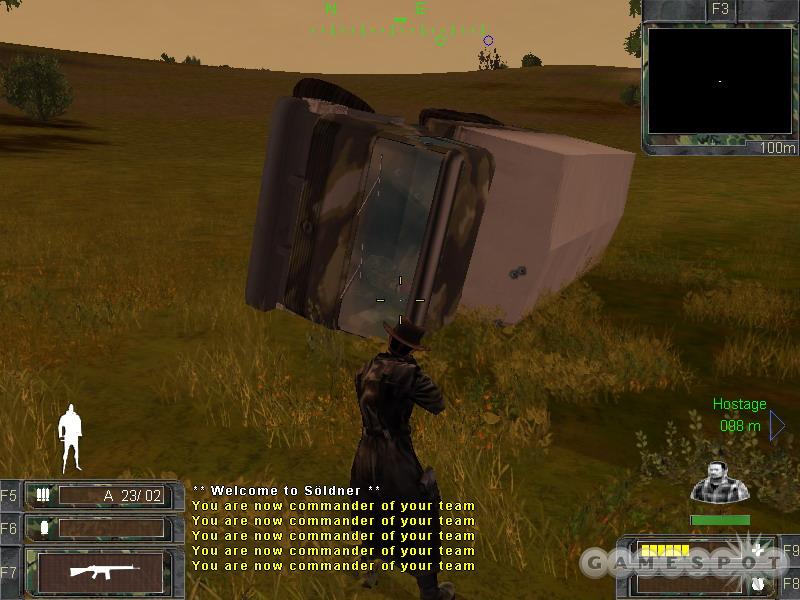Soldner: Secret Wars had the bad luck to arrive in stores just about a week after the very similar Joint Operations: Typhoon Rising. Both games are team-based multiplayer shooters along the lines of the popular Battlefield series, both are set in more or less the modern era, both include a variety of combat vehicles, and both sport a silly, unnecessary subtitle. Unfortunately for the generally rickety-feeling Soldner, Joint Operations is better in virtually every way, except for maybe the subtitle. And even if Soldner was the only game of its kind in town, it still wouldn't be good.

In the year 2010, wars will be fought in secret by "rather small" but highly skilled groups of mercenaries called "Soldners"--at least according to the five or six sentences of plot that are wedged between the customer support number and the system requirements in the manual. The game lets you customize your Soldner's appearance in a variety of ways. You can mix and match different faces, shirts, pants, helmets, boots, gloves, and hairstyles for a unique look. Once you're done picking a wardrobe, your Soldner has access to an impressive number of vehicles and weapons. There are more than 60 different guns in the game and more than 70 different tanks, jeeps, helicopters, and planes (though no boats). While it's nice to have access to such a wide variety of equipment, the game provides no useful information about any of it other than a small, blurry picture and a price. What's the difference between a BMP-2 and a BMP-3? How many crewmembers can an AH-64 carry? Apparently, it's all part of the secret, because there's no such reference material either in the game or in the manual.
This lack of information becomes a problem primarily because Soldner uses an equipment-purchasing system similar to the one used in Counter-Strike. You start each round with a set amount of cash, and you receive cash awards for various things such as enemy kills and securing capture points. Server admins can set the initial funding, but on the default setting, it takes a lot of playing to earn enough to afford most of the vehicles. Despite the vast amount of drivable equipment, the pricing structure ensures that vehicles are actually less common in Soldner than they are in either Joint Operations or the Battlefield series. In a week of playing, we never once saw a single jet in the air, much less a dogfight.
Assuming you can purchase a vehicle, you're not going to be happy with its performance. Nothing in the game controls well. Chopper controls run the gamut from very touchy to absurdly touchy. For instance, it's almost impossible to keep an Osprey's rotors pointed toward the sky. Cars, trucks, and tanks offer no sense of weight, and many of them have a tendency to roll over at the slightest provocation. You can flip an Abrams tank just by turning it too sharply on level ground.
The game's interface is sluggish and ugly. There often seems to be a distinct lag between clicking something or pressing an action key and seeing an effect. Some interface elements are just baffling. For instance, a key press toggles sprinting, but sidestepping turns the sprint off. Maybe there's some realism excuse for this, but from a player standpoint, it's counterintuitive and annoying. Moreover, Soldner represents a devolution of certain heads-up display elements standard to other games in the genre. When you're inside a vehicle, both Battlefield 1942 and Joint Ops display a diagram of the vehicle that shows both your position and the other available seats. Soldner abandons this clean, clear design element in favor of a single number in parentheses that represents the vehicle's current number of occupants. Since the game relays no information about any of the vehicles, the only way to figure out how many people will fit into a given craft is to actually load players into it until the game tells you that you can't anymore.
Graphics and sound are generally average. Character models are detailed, and the levels feature some impressive view distances. But individual elements in the environment are more often than not kind of ugly, blocky, and plain. The game also includes one of the worst, most distracting rain effects in gaming history. And, for some reason, a bored-sounding guy says "Soldner" pretty much any time a new menu loads.
Several different multiplayer game types are available. The most popular is conquest, which is just like the multiflag capture-and-hold gameplay in the Battlefield series. And "popular" is a relative term here. Though the game has spent more than a week on store shelves, it's rare to find more than 100 players online at any given time. There are often fewer than 50. Maps support only 32 players at once, though the steep server requirements keep many of the available servers locked at 16 or 24. While playing, we also experienced several lockups and crashes to the desktop.
There is a single-player campaign included in Soldner. It's an endless series of randomly generated missions. It's also broken. The bot AI is awful--enemies put up nothing more than a token resistance and often get stuck running against walls, rocks, and trees. They'll drive vehicles, but usually only long enough to flip them over or crash them repeatedly into any intervening obstacle. Worse, after five missions, something happens that causes the game's frame rate to drop to unplayable levels, even on equipment that far exceeds the recommended system requirements. So even if you wanted to play the single-player game, it's almost impossible.
Soldner does feature some neat innovations. For instance, environments are fully destructible. Buildings and trees can be knocked down, and you can even blow chunks right out of the ground, which can make it harder for vehicles to approach an entrenched position. Unfortunately, though, these original elements can't compensate for Soldner's fundamental stability, control, and gameplay problems.
